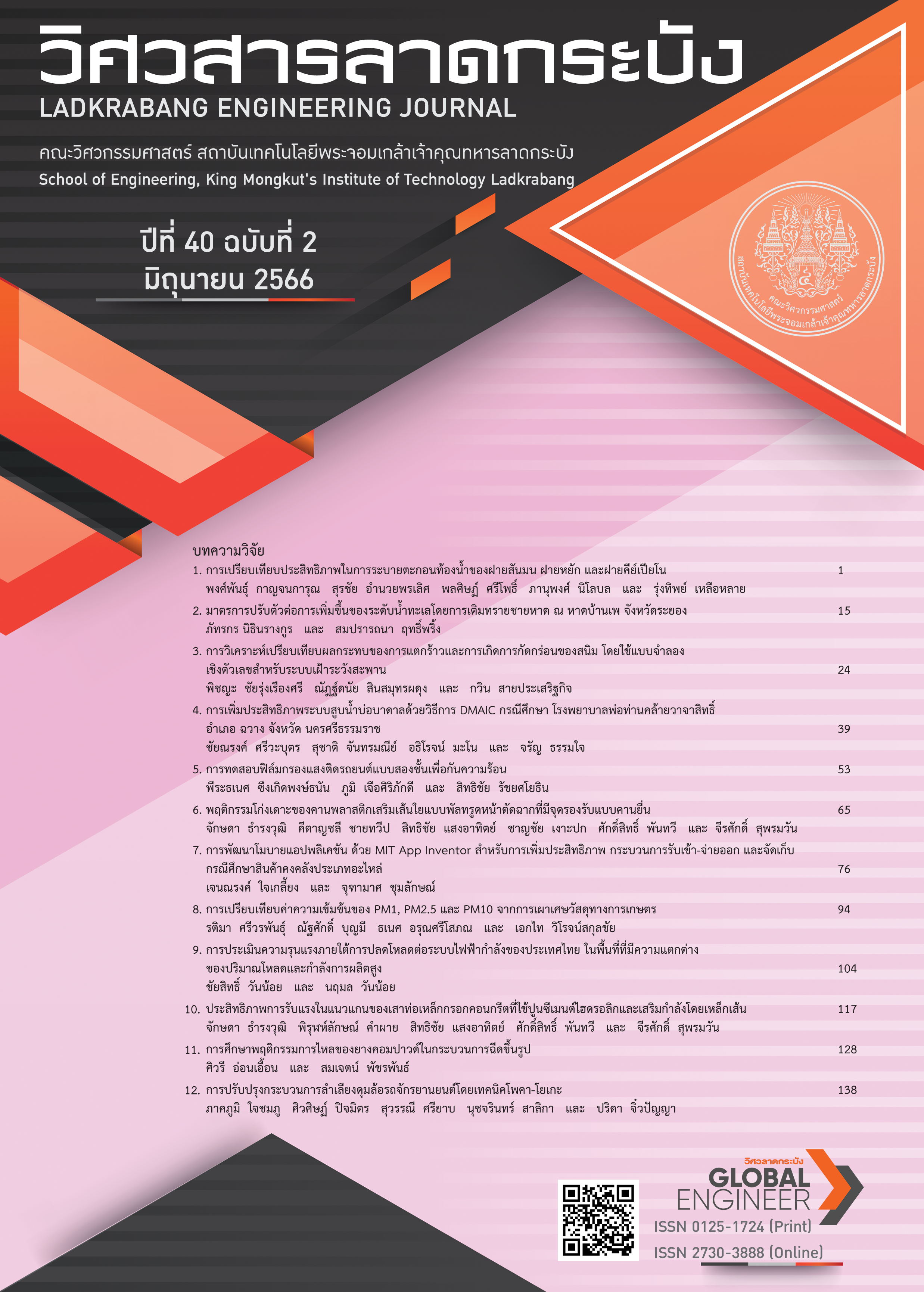Improvement of Motorcycle Wheel Hubs Conveyor rail Process by Poka-yoke Techniques
Keywords:
Poka yoke principle, Production process improvement, Reducing wasted timeAbstract
This research aims to improve the process of transporting motorcycle wheel hubs that are stuck on the conveyor rails. From the analysis using the fishbone chart, it was found that the motorcycle wheels hub conveyor has several flaws such as the castors in the conveyor chute being damaged due to the plastic castors. The aluminum wheels hubs move along the conveyor chute with a slope of 3 levels, causing the problem of impact between the workpiece and the caster. This causes damage, leads to work jams, and is the most contributing factor in time wasted. The research team collected data before the improvement of the conveyor rail collecting 207 pieces of data. There were 116 pieces of work that prevented the work from continuing accounting for 56.04 percent. After improving the conveyor rail using the Poka-yoke technique to prevent errors. Install guides to steer the direction. Changing the rails from plastic casters to stainless steel plates and installing a workpiece shock absorber to reduce the jamming of the workpiece. Found that the problem was 13 pieces, representing 6.28 percent, which reduced the problem of parts during the transport of the motorcycle wheel hub from 88.80 percent. It can be concluded that the improvement of the motorcycle hub conveyor can reduce the jamming time of the workpiece for the intended purpose.
References
Automotive Industry Possibilities of Thai Industry, Sumipol Agile Technology. May 23, 2018. [Online]. Available: https://www.sumipol.com/knowledge/Industry
J. Pintong, C. Mongkol, A. Surakul, P. Kritratpon, S. Prajongsak and N.Hongsachart, “Line Efficiency Improvement for Part MJEA and MGZA of Shaft Water Pump Model Case Study: Automotive Parts Company,” Journal of Rajanagarindra, vol 17, no 1, pp. 125–131, 2017.
M. fisher, “Process improvement by poka-yoke,” Work Study, vol. 48, no. 7, pp. 264–226, 1999, doi: 10.1108/00438029910294153.
M. Dudek-Burlikowska and D. Szewieczek, “The Poka-Yoke method as an improving quality tool of operations in the process,” Journal of Achievement in Materials and Manufacturing Engineering, vol. 36, no. 1, pp. 95–102, 2009.
N. K. Shimbun, “Overview of Poka-yoke,” in Poka-Yoke Improving Product Quality by Preventing Defects, 1st ed. Portland, OR, USA: Productivity Pres, 1988, ch. 1, pp. 1–28.
S. Patel, B. G. Dale and P. Shaw, “Set-up time reduction and mistake proofing methods: an examination in precision component manufacturing,” The TQM Magazine, vol. 13, no. 3, pp. 175–179, 2001, doi: 10.1108/09544780110385528.
S. Khophonklang, “Cause and Effect Diagram,” in Quality Control, 1th ed. Bangkok, Thailand: Skybook, 2001, ch. 5, sec. 5.4, pp.126.
P. Nanjundaraj, V. Kannan, P. Sangeetha and S. Umamaheswari, “A Study on implementation of POKA–YOKE technique in improving the operational performance by reducing the rejection rate in the assembly Line”, International Journal of Pure and Applied Mathematics, vol. 119, no. 17, pp. 2177–2191, 2018.
A. Semsri, A. Suksukon, S. Sisamut and T Pudtipatkosit, “Quality Control and Loss Reduction in the Front Side Fender Model Assembly Process Using Poka-Yoke Techniques,” RMUTP Research Journal, vol. 15, no. 2, pp. 103–117, 2021.
P. Prommaboon, A. Intawongsa, P. Ponlux, P. Nokaew, N. Kitpaisansakun and S. Tipkhat, “The Design and Building of a Conveyor-Belt System (Case study: CPF Trading Co., ltd. Lampang Branch),” Industrial Technology Lampang Rajabhat University Journal, vol. 9, no1, pp. 14–21, 2016.
P. Pitak, O. Phanbualuang, K. Chongwatanarak and K. Phaewthaisong, “Efficiency Improvement of Production Line Using Gravity Roller System”, Academic Journal of Thonburi University (Science and Technology), vol. 2, no. 2, pp. 42–52, 2018.
Downloads
Published
How to Cite
Issue
Section
License
Copyright (c) 2023 Faculty of Engineering, King Mongkut’s Institute of Technology Ladkrabang

This work is licensed under a Creative Commons Attribution-NonCommercial-NoDerivatives 4.0 International License.
The published articles are copyrighted by the School of Engineering, King Mongkut's Institute of Technology Ladkrabang.
The statements contained in each article in this academic journal are the personal opinions of each author and are not related to King Mongkut's Institute of Technology Ladkrabang and other faculty members in the institute.
Responsibility for all elements of each article belongs to each author; If there are any mistakes, each author is solely responsible for his own articles.






